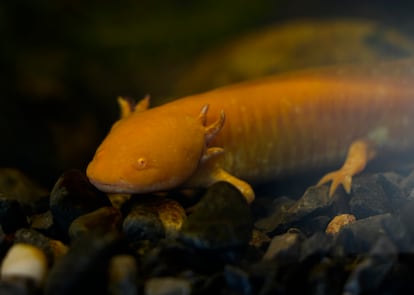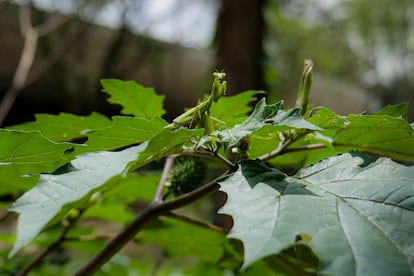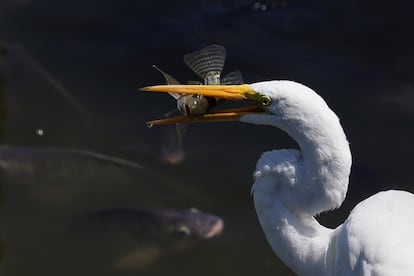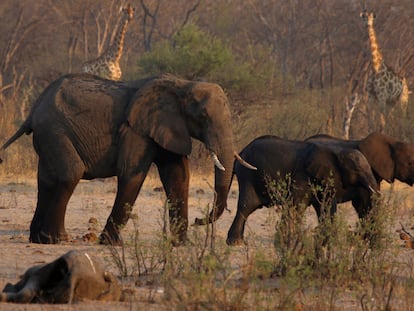Opossums, axolotls and lichens in Chapultepec: The largest urban forest in Latin America takes inventory
A group of experts is creating a unique catalog in record time of all the living beings that inhabit Mexico City’s iconic park. They hope to register some 500 species to ensure their conservation

On the morning of the first Monday in September, under a cloudy sky, small groups of individuals carrying binoculars, magnifying glasses, butterfly nets, tweezers and jars are moving slowly through the greenery of the first section of Chapultepec Park, in Mexico City. Wearing field boots, they stop along the paths that cross the Botanical Garden, very attentive to what they can find under the serrated leaf of an agave, the low branch of a tree or the bark of a fallen trunk. They are the explorers who make up the team in charge of making an inventory of all the biodiversity that inhabits the most iconic park in the Mexican capital, and they have 24 hours to do so.

The initiative seeks to document each of the species that live in the largest urban park in Latin America, which, according to experts, could exceed 500, including those that are already registered and any new ones that may be found through this project, which is called a bioblitz: a scientific event where the objective is to census as many living beings as possible in a defined place and period of time. The activity also aims to contribute to connecting the public with its environment, creating awareness and an interest in nature. The hope is that this exhaustive classification effort will help officials make better decisions about the conservation management of this natural space, the green lung of Mexico City.
To this end, 30 specialists from various fields of biology and some 200 students spent morning and night searching for all the living beings hidden inside the forest: birds, fish, frogs, axolotls, reptiles, insects, mammals, all kinds of plants and trees... But also other specimens that do not belong to the animal or plant kingdom, such as fungi, algae and lichens that make up the biodiversity of Chapultepec. “It is one of the most beloved and visited places by Mexicans,” said the head of the Mexico City Environment Secretariat (SEDEMA), Marina Robles, during the news conference to present the initiative on Monday.

Recognized for the value it brings to the city as the Best Park in the World in 2019, a distinction awarded by the World Urban Parks association, Chapultepec not only stands out worldwide for its natural wealth but also for the cultural and anthropological history that runs through its extensive spaces, from archaeological sites, its more than 10 museums, numerous artistic centers, and artificial lakes. Inhabited by different civilizations since pre-Hispanic times, this centuries-old spot covering nearly 800 hectares receives 24,000 visitors a year. “And despite all the movement, any day you can see an opossum crossing its paths with its babies on its back,” says Mónica Pacheco Skidmore, executive director of the park.
Although experts have already listed a large portion of the species that Chapultepec is home to, they are convinced that thanks to this activity they will be able to add many others that were not part of the current catalog and register some that were unexpected. “Like when in the bioblitz that was organized in [New York’s] Central Park in 2003, the first one I participated in, a coyote showed up to everyone’s surprise. And that’s despite the fact that this park is less diverse, much younger and has less of a history than the Mexican one,” says Rodrigo Medellín, a biologist at the UNAM Ecology Institute and one of the pioneers of the initiative.
After 24 hours of searching for all the area’s living beings, the researchers will make the results of their efforts public within 15 days through a digital platform accessible to all citizens. Although this year the experts are only recording the species from the first section of the park, the activity will be repeated next year in the second section, and in successive years in the third and fourth until a complete inventory is obtained. “The idea is to carry out the same experiment in a decade and prove that Chapultepec maintains its natural wealth,” said the head of SEDEMA.

In addition to creating the most comprehensive inventory of the rich biodiversity that lives within the heart of one of the largest and most polluted megalopolises in the world, and serving as a tool for improving the environmental conditions and services of this space, the biologist Medellín wants the activity to help citizens get to know the creatures with whom they share space up close. “Who doesn’t want to meet their neighbors, those with whom they have to live on their walks? We want the bioblitz to also make visitors to the forest fall in love with the nature that surrounds us and from which we come!”
Sign up for our weekly newsletter to get more English-language news coverage from EL PAÍS USA Edition
Tu suscripción se está usando en otro dispositivo
¿Quieres añadir otro usuario a tu suscripción?
Si continúas leyendo en este dispositivo, no se podrá leer en el otro.
FlechaTu suscripción se está usando en otro dispositivo y solo puedes acceder a EL PAÍS desde un dispositivo a la vez.
Si quieres compartir tu cuenta, cambia tu suscripción a la modalidad Premium, así podrás añadir otro usuario. Cada uno accederá con su propia cuenta de email, lo que os permitirá personalizar vuestra experiencia en EL PAÍS.
¿Tienes una suscripción de empresa? Accede aquí para contratar más cuentas.
En el caso de no saber quién está usando tu cuenta, te recomendamos cambiar tu contraseña aquí.
Si decides continuar compartiendo tu cuenta, este mensaje se mostrará en tu dispositivo y en el de la otra persona que está usando tu cuenta de forma indefinida, afectando a tu experiencia de lectura. Puedes consultar aquí los términos y condiciones de la suscripción digital.
More information
Archived In
Últimas noticias
Most viewed
- Oona Chaplin: ‘I told James Cameron that I was living in a treehouse and starting a permaculture project with a friend’
- Sinaloa Cartel war is taking its toll on Los Chapitos
- Reinhard Genzel, Nobel laureate in physics: ‘One-minute videos will never give you the truth’
- Why the price of coffee has skyrocketed: from Brazilian plantations to specialty coffee houses
- Silver prices are going crazy: This is what’s fueling the rally










































